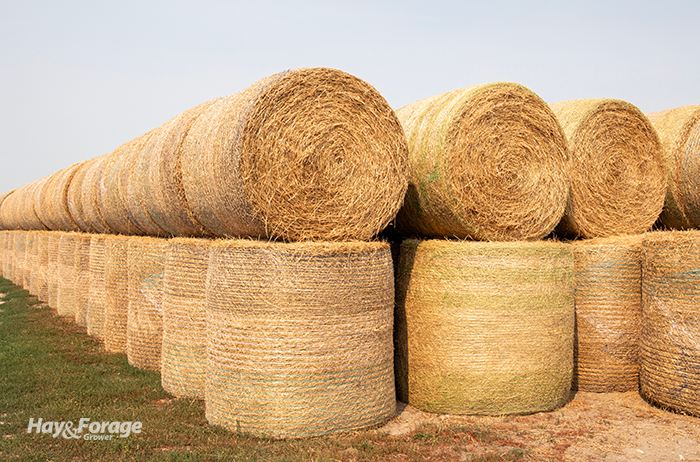What’s wrong with stacking round bales? |
| By Amber Friedrichsen, Associate Editor |
|
|
 Moving round bales out of a field and under cover may seem like one more item on the to-do list of a busy hay season, but rushing to complete this step may result in improper storage that can squander the forage yield and quality farmers worked so hard to achieve. In a recent article from the Midwest Forage Association’s Clippings newsletter, Sarah Bauder with South Dakota State University encourages best storage practices to conserve dry matter and quality in round bales. The forage field specialist suggests bale storage is just as important to product value as plant maturity, harvest management, and pest control. Dry matter and quality losses occur when water is trapped in hay and causes spoilage. This can be exacerbated by several factors, including hay binding, storage structures, bale stacking, and time. Densely made bales are better equipped to exclude excess moisture, and the shape of a round bale is more conducive to shedding water compared to a square one. Bauder added that different forage species have different water-shedding capabilities. For example, grasses have broad, flat leaf blades that can prevent water from penetrating bales better than smaller alfalfa leaves. Field day findings At a field day in 2019, Bauder conducted a demonstration with an electric probe to measure moisture levels in bales that were stored on various sites at a farm that received over 20 inches of rainfall throughout the season. Approximately 50 samples were taken at an 8-inch depth from the flat face of each bale and used to create spatial maps of moisture. For bales stored under an open shed, approximately 98% of the sampling area measured 20% moisture or less. Conversely, more than two-thirds of the sampling area of bales stored outside in tightly packed rows exceeded 22% moisture. Bales stored in the middle and bottom tiers of a stacked pyramid shape retained even more moisture, with over 35% of the sampling areas exceeding 30%. “Water tends to shed from upper bales into the lower layer where limited air movement and sun exposure deteriorate the bales,” Bauder explains. “The bottom bales also tend to squat, creating more contact with the ground and increasing moisture wicking.” Mushroom stacking — or placing one bale on its flat side and placing a second bale on its round side on top — caused the most spoilage. In fact, data showed more than 45% of the sampling area of the bottom bale in a mushroom stack was over 35% moisture. Overall, Bauder said the results from the field day aligned with typical storage recommendations. Protecting round bales under a roof is the best option; however, there are ways to prevent spoilage if bales must be stored outside. • Avoid stacking bales. If bales must be stacked due to limited storage space, cover the pile with plastic. • Utilize net wrap instead of twine to help bales shed excess water and maintain integrity and shape. • Do not place bales in a shaded area; keep them in the sun as much as possible. This allows for better drying after bales have been exposed to precipitation. • Locate a south-facing slope for bale storage to promote water drainage. Additionally, establish a well-drained surface, such as gravel or a rock pad, to further reduce water wicking. • Orient bales in rows from north to south with 3 to 4 feet in between rows. Bauder notes that butting bales together tightly protects the flat faces from rain and snow accumulation, whereas a 12- to 18-inch gap between individual bales allows for better airflow. With that said, there is no research consensus on the ideal distance between bales. |
